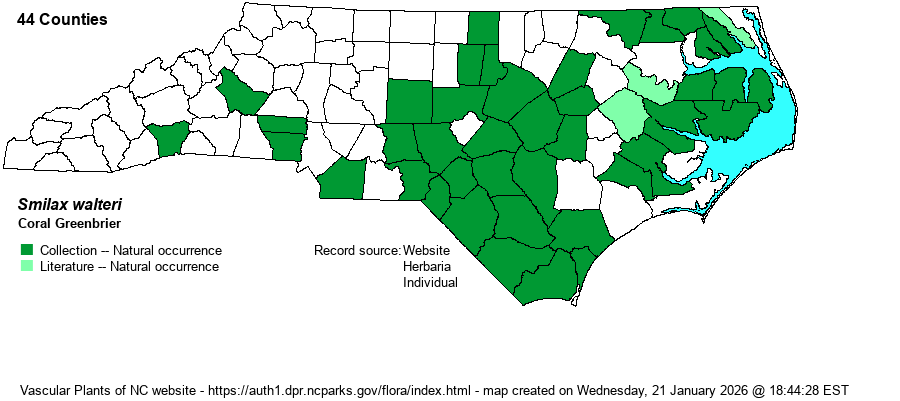| Author | Pursh | |
| Distribution | Nearly throughout the Coastal Plain, though no collections yet for some counties. Sparingly west to the eastern Piedmont, with a few records for the western Piedmont. Absent from the Mountains and northwestern Piedmont, except for a record for Henderson County.
A Southern species, primarily of the Coastal Plain. Ranges north to NJ, and south to central FL and eastern TX. Inland, reaches as far north as southwestern TN in the Mississippi Embayment.
| |
| Abundance | Fairly common to locally common in parts of the Coastal Plain, common in the Sandhills. Infrequent in the central Coastal Plain counties, but more numerous on the Pamlimarle Peninsula. Rare in the eastern Piedmont, and very rare in the western Piedmont and eastern edge of the Mountains. | |
| Habitat | This is our most “aquatic” greenbrier, being restricted to areas with shallow water of swamps, beaver ponds, very wet streamhead thickets, and wooded pools. It is generally rooted in shallow water. |
| Phenology | Blooms in late April and May, and fruits from September to November, and persisting – thankfully – into winter. | |
| Identification | This is a slender woody vine, with clearly deciduous leaves, not typically climbing high, but instead more often seen climbing over small trees and shrubs. It is mostly an unarmed species, though a scattering of narrow spines may be present near the base. The leaves are similar to those of S. rotundifolia – being ovate and pointed at the tip. On average, the leaves are a bit narrower than those of the other species. It is easily identified in fall and winter by the bright red berries, which thankfully are retained well after the leaves drop. A bare vine with bright red berries is usually this species, though Coralbeads (Cocculus carolinus) also has red berries, but these are quite glossy and usually do not remain into winter. When the red fruit are not visible, take care separating this from the abundant S. rotundifolia, which usually does not root in shallow water, and which almost always has a number of green thorns scattered along the stems. Smilax smallii can look somewhat similar, but that species has leaves that are tapered/cuneate at the base as opposed to more rounded; by fall, S. walteri leaves start to drop and red berries begin to show, whereas S. smallii is evergreen and does not have red berries. | |
| Taxonomic Comments | None
| |
| Other Common Name(s) | Red-berried Greenbrier, Red-berried Bamboo | |
| State Rank | S5 | |
| Global Rank | G5 | |
| State Status | | |
| US Status | | |
| USACE-agcp | OBL link |
| USACE-emp | OBL link |

